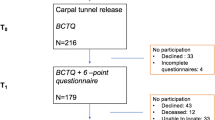Abstract
Although many studies on carpal tunnel syndrome (CTS) have been reported, few data on the natural history of CTS are available. Knowledge of the natural course of the disease has significant clinical and therapeutic value. We prospectively followed up 80 cases of untreated CTS. The evaluation was based on self-administered questionnaires and on neurophysiological investigation. According to the neurophysiological classification, cases of CTS were divided into six groups on the basis of impairment severity: negative, minimal, mild, moderate, severe, and extreme. Disease worsening was inversely related to severity of nerve entrapment. On the contrary, improvement was proportionally related to nerve function impairment (except for extreme cases that never improved), and about one-third of mild and moderate cases improved. Most minimally cases remained neurophysiologically unchanged. We hypothesize that in a good percentage of CTS cases, nerve impairment is self-limited. Our data suggest the utility of further studies on the natural course of this common disease.
Sommario
Sebbene siano stati effettuati molti studi sulla sindrome del tunnel carpale (STC), in letteratura sono riportati pochi dati sulla storia naturale di tale patologia. La conoscenza dell'evoluzione naturale ha molte implicazioni cliniche e terapeutiche. Abbiamo eseguito prospetticamente il follow-up di 80 mani affette da STC non trattate. La valutazione è stata basata su un questionario auto -somministrato e sull'esame neurofisiologico. Le mani sono state divise secondo la classificazione neurofisiologica in STC negativa, minima, lieve, medio, grave, estrema.
Il peggioramento è apparso inversamente correlato al grado di sofferenza del nervo, al contrario il miglioramento è apparso proporzionale alla compromissione della funzione nervosa (ad eccezione dei casi estremi the non sono mai migliorati), circa un terzo dei casi lievi e medi sono migliorati. La maggior parte dei casi minimi sono rimasti neurofisiologicamente invariati. Le nostre osservazioni suggeriscono che in una buona percentuale dei casi affetti da STC avviene un'autolimitazione della sindrome. I nostri dati suggeriscono ulteriori studi sulla naturale evoluzione di questa comune patologia.
Similar content being viewed by others
References
AAN Quality Standards Subcommittee (1993) Practice parameter for carpal tunnel syndrome (Summary statement). Neurology 43:2406–2409
AAEM Quality Assurance Committee (1993) Literature review of the usefulness of nerve conduction studies and electromyography for the evaluation of patients with carpal tunnel syndrome. Muscle Nerve 16:1392–1414
Padua L, LoMonaco M, Valente EM, Tonali P (1996) A useful electrophysiologic parameter for diagnosis of carpal tunnel syndrome. Muscle Nerve 19:48–53
Stevens C (1987) The electrodiagnosis of carpal tunnel syndrome. Muscle Nerve 10:99–113 (AAEE minimonograph 26)
Uncini A, Di Muzio A, Awad J, Manente G, Tafuro M, Gambi D (1993) Sensitivity of three median-to-ulnar comparative tests in diagnosis of mild carpal tunnel syndrome. Muscle Nerve 16:1366–1373
Giannini F, Passaro S, Cioni R et al (1991) Electrophysiologic evaluation of local steroid injection in carpal tunnel syndrome. Arch Phys Med Rehabil 72:738–742
Girlanda P, Dattola R, Venuto C, Mangiapane R, Nicolosi C, Messina C (1993) Local steroid treatment in idiopathic carpal tunnel syndrome. Short- and long-term efficacy. J Neurol 240:187–190
Haupt WF, Wintzer G, Schop A, Löttgen J, Pawlik G (1993) Long-term results of carpal tunnel decompression. J Hand Surg 18B:471–474
Mühlau G, Both R, Kunath H (1984) Carpal tunnel syndrome — course and prognosis. J Neurol 231:83–86
Seror P, Bectarte M, Mortier JP (1988) Syndrome du canal carpien. Aspect electrophysioloqeus de l'evolution naturelle et après traitment. Rev Chir Orthopédique 74:466–472
Padua L, LoMonaco M, Gregori B, Valente EM, Padua R, Tonali P (1997) Neurophysiological classification and sensitivity in 500 carpal tunnel syndrome hands. Acta Neurol Scand 96:211–217
Padua L, LoMonaco M, Aulisa L, Tamburrelli F, Valente EM, Padua R, Gregori B, Tonali P (1996) Surgical prognosis in carpal tunnel syndrome: Usefulness of a preoperative neurophysiological assessment. Acta Neurol Scand 94:343–346
Padua L, LoMonaco M, Padua R, Gregori B, Tonali P (1997) Neurophysiological classification of carpal tunnel syndrome assessment of 600 symptomatic hands. It J Neurol Sci 18(3):145–150
Author information
Authors and Affiliations
Rights and permissions
About this article
Cite this article
Padua, L., Lo Monaco, M., Aprile, I. et al. Natural history of carpal tunnel syndrome according to the neurophysiological classification. Ital J Neuro Sci 19, 357–361 (1998). https://doi.org/10.1007/BF02341782
Received:
Accepted:
Issue Date:
DOI: https://doi.org/10.1007/BF02341782




